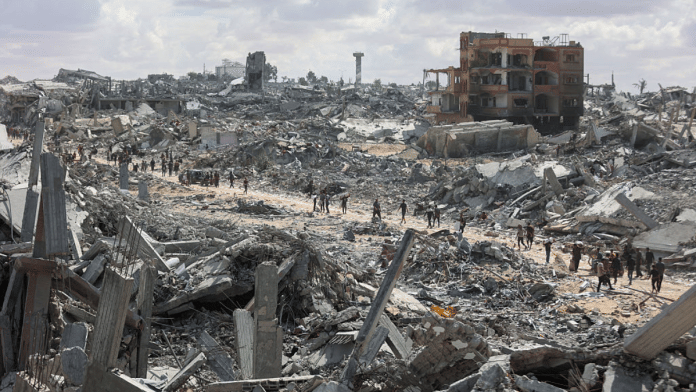The two-week-old Gaza ceasefire faces seemingly intractable disputes over Hamas disarmament, foreign troop participation, Israeli withdrawals and future governance. For now, many Israelis and Palestinians are finding a common cause: locating, identifying and burying their dead.
Hamas still needs to hand over the bodies of 13 dead hostages to Israel, which has accused the Islamist faction of stalling in order to head off tougher truce obligations. With US President Donald Trump impatient to see his peace plan proceed, Egypt sent in teams and equipment at the weekend to help excavate for the remains.
Palestinians unaccounted for and presumed dead are far more numerous — potentially as many as 10,000. In the devastation left by two years of war, with entire districts bombed or bulldozed into rubble, no one knows for sure. Those bodies recovered, including from the Israeli army in negotiated handovers, are often ravaged beyond recognition.
That has put unprecedented pressure on Gaza’s shattered health services. Morgues that once took in fresh fatalities from the fighting now accommodate decomposing corpses, tagged with numbers in lieu of names. Some are roped or handcuffed and contorted. Others have been dismembered or crushed by tanks.
Under a makeshift tent outside Nasser Hospital in southern Gaza, pictures of bodies or body parts are on display for Palestinians who lost next-of-kin to inspect.
“Those who think the remains belong to their family members go inside and examine the bodies. The scenes are horrifying,” said Akram al-Manasra, who travels by bus daily from northern Gaza City to Nasser to find a son who’s been missing since the Oct. 7, 2023, attack by Hamas on Israel that triggered the war.
That hasn’t happened yet, Al-Manasra says. Absolute certainty is elusive. Of the approximately 200 bodies provided by Israel in return for 15 hostage remains transferred by Hamas so far, fewer than a third have been identified, according to the Health Ministry.
“We don’t have DNA labs or advanced technology to identify the bodies,” said Ahmed Dhair, a senior forensic official. “We rely on distinctive marks, body build, wounds, scars, facial features, clothes, disfigurements and age-related changes.”
By contrast, each body received in Israel from Gaza has been ferried under police protection to a top Tel Aviv laboratory, with a DNA match provided within hours. One set of remains handed over by Hamas proved to be that of an anonymous Palestinian.
A stretch of Gaza sand dunes was turned into a burial site for 54 unclaimed bodies last week. Dozens of Palestinian medics, recovery personnel and mourners paid their respects as the white coffins were lowered into the ground.
Al-Manasra fears that his 28-year-old son, Khaled, will remain missing or end up in such an unmarked grave.
“Even if I get two bones of his body, I want to bury them respectfully and build a tomb so we can visit it,” he said in a telephone interview. “Our hearts are burning, and will continue burning until we find him and bury him.”
Trump’s Gaza plan hinges on the recovery of all hostages — but not of all the Palestinian dead. That has deepened the bitterness of bereavement.
Eid al-Habeel says he lost nine relatives in an Israeli air strike that flattened their home in Gaza City in September. The body of his mother was extricated from the debris — but not the other eight fatalities, as Israeli troops advanced and ordered civilians to evacuate.
After the ceasefire began on Oct. 10, al-Habeel returned to the site and, with the help of family and friends, dug until six more bodies were recovered. Two nephews remain unearthed.
“We used shovels and sledgehammers to break through the concrete slabs and entangled wires, but we could not reach them,” he said, adding that the municipal crews that turned up also lacked the heavy equipment needed to tackle the rubble.
That’s not the case for the Hamas teams tasked with finding hostage remains, Eid said, recalling the sight of bulldozers digging into the remains of an underground tunnel for one body.
“It’s like we’re not humans. Our children are left for the dogs, but for the Israelis they move heaven and earth,” he said.
(Reporting by Fares Akram with assistance from Dan Williams)
Disclaimer: This report is auto generated from the Bloomberg news service. ThePrint holds no responsibility for its content.






